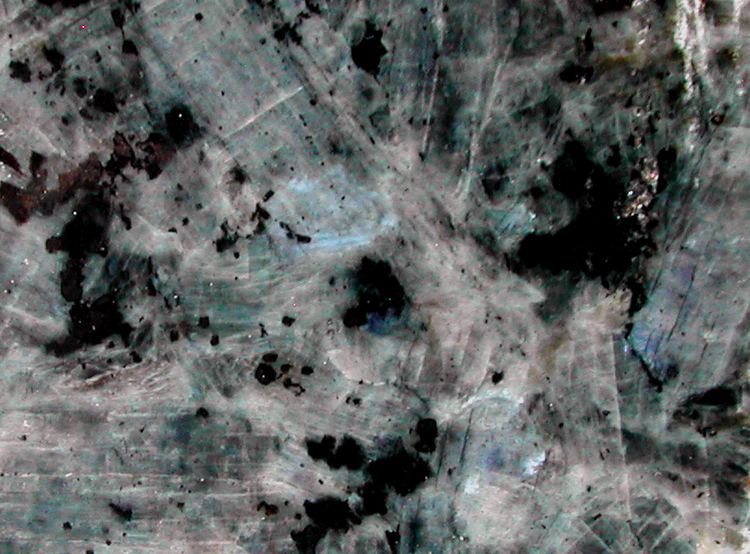Crystal system Triclinic | ||
 | ||
Category Feldspar, tectosilicate Crystal class Pinacoidal (1)(same H-M symbol) Unit cell a = 8.155 Å, b = 12.84 Åc = 10.16 Å; α = 93.5°β = 116.25°, γ = 89.133°; Z = 6 Color Gray, brown, greenish, blue, yellow, colorless | ||
Labradorite ((Ca, Na)(Al, Si)4O8), a feldspar mineral, is an intermediate to calcic member of the plagioclase series. It has an anorthite percentage (%An) of between 50 and 70. The specific gravity ranges from 2.68 to 2.72. The streak is white, like most silicates. The refractive index ranges from 1.559 to 1.573. Twinning is common. As with all plagioclase members, the crystal system is triclinic, and three directions of cleavage are present, two of which form nearly right angle prisms. It occurs as clear, white to gray, blocky to lath shaped grains in common mafic igneous rocks such as basalt and gabbro, as well as in anorthosites.
Contents
Occurrence
The geological type area for labradorite is Paul's Island near the town of Nain in Labrador, Canada. It has also been reported in Norway and various other locations worldwide.
Labradorite occurs in mafic igneous rocks and is the feldspar variety most common in basalt and gabbro. The uncommon anorthosite bodies are composed almost entirely of labradorite. It also is found in metamorphic amphibolites and as a detrital component of some sediments. Common mineral associates in igneous rocks include olivine, pyroxenes, amphiboles and magnetite.
Labradorescence
Labradorite can display an iridescent optical effect (or schiller) known as labradorescence. The term labradoresence was coined by Ove Balthasar Bøggild, who defined it (labradorization) as follows:
Labradorization is the peculiar reflection of the light from submicroscopical planes orientated in one direction (rarely in two directions); these planes have never such a position that they can be expressed by simple indices, and they are not directly visible under the microscope.
Contributions to the understanding of the origin and cause of the effect were made by Rayleigh (1923), and by Bøggild (1924).
The cause of this optical phenomenon is phase exsolution lamellar structure, occurring in the Bøggild miscibility gap. The effect is visible when the lamellar separation is between 128 to 252 nm (5.0×10−6 to 9.9×10−6 in); the lamellae are not necessarily parallel; and the lamellar structure is found to lack long range order.
Relationships between lamellar separation and chemical composition have been found for the An (Anorthite) content (calcium rich plagioclase) of the mineral.
Some gemstone varieties of labradorite exhibiting a high degree of labradorescence are called spectrolite.
